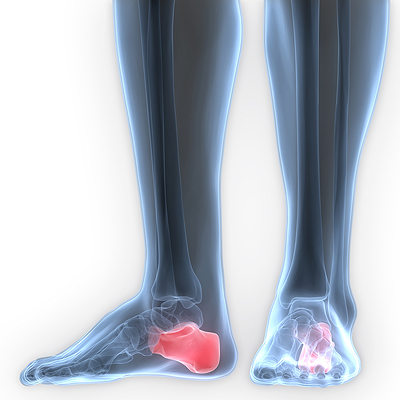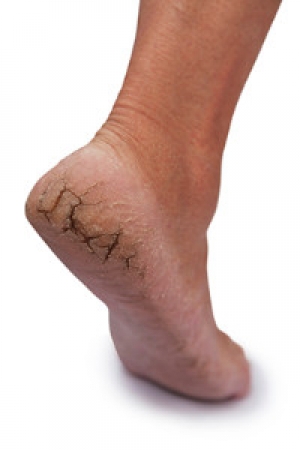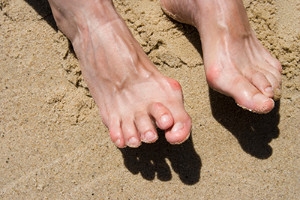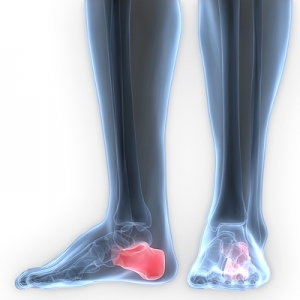
Flat Feet
Flatfoot is a foot condition in which the arch of the foot has either partially or totally dropped or has never developed. While it is common in babies and small children, it can become a problem for them in adulthood if the arch never forms. For adults, the development of flat feet can be brought upon by injury, as a result of pregnancy due to increased elasticity, or obesity. Those who have health concerns such as rheumatoid arthritis or diabetes may also be at greater risk for developing the condition.
If you suspect that you have flat feet, it is best to consult your podiatrist. Your foot doctor will examine the suspected foot and observe how it looks while you sit and stand. He or she may take an X-ray to determine how serious the condition is. Some common signs of flatfoot include toe drift, in which the toes and front part of the foot point outward, a short Achilles tendon, and a heel that tilts outwardly while the ankle tilts inward.
Once flatfoot has been diagnosed, your podiatrist may suggest one of several treatment options. Flat feet can be rigid, in which the feet appear to have no arch even when the person is not standing; or flexible, in which the person appears to have an arch while not standing, but once standing the arch disappears. Those with flexible flatfoot may be told to reduce any activities that cause pain and to avoid extended periods of walking or standing. Another suggestion may be weight loss, as excessive weight may be placing pressure on the arches
In few cases, if the condition is severe and all other methods have been exhausted surgery may be required. This is normally avoided, however, due to a lengthy recovery time and high cost.
Causes of Cracked Heels
 The skin on our heels is considerably thicker than the rest of the body because of the amount of pressure and stress the feet must endure. If your heels are dry, itchy, and the skin appears flaked, you may have a condition referred to as cracked heels. Many people suffer from cracked heels, often due to a number of factors. The type of lifestyle that is led may be a cause of this ailment, as it may include a lack of exercise and a diet high in complex carbohydrates, which may affect the circulation in the feet. The skin can lose elasticity, and may be prone to forming fissures, or cracks in the skin. Additional factors may include not taking care of your feet properly, standing most of the day, and being in cold weather. Treatment options may include utilizing a moisturizer after soaking the feet in warm, soapy water. If this condition persists or becomes severe, a consultation with a podiatrist is suggested for advice and information on how to treat cracked heels.
The skin on our heels is considerably thicker than the rest of the body because of the amount of pressure and stress the feet must endure. If your heels are dry, itchy, and the skin appears flaked, you may have a condition referred to as cracked heels. Many people suffer from cracked heels, often due to a number of factors. The type of lifestyle that is led may be a cause of this ailment, as it may include a lack of exercise and a diet high in complex carbohydrates, which may affect the circulation in the feet. The skin can lose elasticity, and may be prone to forming fissures, or cracks in the skin. Additional factors may include not taking care of your feet properly, standing most of the day, and being in cold weather. Treatment options may include utilizing a moisturizer after soaking the feet in warm, soapy water. If this condition persists or becomes severe, a consultation with a podiatrist is suggested for advice and information on how to treat cracked heels.
Cracked heels are unsightly and can cause further damage to your shoes and feet. If you have any concerns, contact one of our podiatrists from Princeton Foot and Ankle Associates. Our doctors can provide the care you need to keep you pain-free and on your feet.
Cracked Heels
Cracked heels appear unappealing and can make it harder for you walk around in sandals. Aside from looking unpleasant, cracked heels can also tear stockings, socks, and wear out your shoes. There are several methods to help restore a cracked heel and prevent further damage.
How Do You Get Them?
Dry skin is the number one culprit in creating cracked heels. Many athletes, walkers, joggers, and even swimmers suffer from cracked heels. Age and skin oil production play a role to getting cracked heels as well.
Promote Healing
Over the counter medicines can help, especially for those that need instant relief or who suffer from chronic dry feet.
Wear Socks – Wearing socks with medicated creams helps lock in moisture.
Moisturizers – Applying both day and night will help alleviate dryness which causes cracking.
Pumice Stones – These exfoliate and remove dead skin, which allows for smoother moisturizer application and better absorption into the skin.
Change in Diet
Eating healthy with a well-balanced diet will give the skin a fresh and radiant look. Your body responds to the kinds of food you ingest. Omega-3 fatty acids and zinc supplements can also revitalize skin tissue.
Most importantly, seek professional help if unsure how to proceed in treating cracked heels. A podiatrist will help you with any questions or information needed.
If you have any questions, please feel free to contact our offices located in Princeton, and West Windsor, NJ . We offer the newest diagnostic and treatment technologies for all your foot care needs.
Solutions for Cracked Heels
Cracked heels can make life very frustrating and embarrassing when displaying the bare feet. Aside from being unpleasing to the eye, they can also tear stockings and socks and wear out shoes at a faster rate. When severe, cracked heels may cause pain or infection.
Cracked heels are a problem for those who are athletic, those who may walk a lot, and those who have especially dry skin. Those who use medication that dry the skin, those who swim often, wearing certain types of shoes, and those who are diabetic may have trouble with cracked heels. Seniors whose skin produces less oil may also have trouble with cracked feet. There is no one way to develop cracked feet, and there is no cure.
Today, the market consists of numerous products that have a variety of ingredients to promote healing. Some of these are over-the-counter. Others are prescribed by a doctor, especially for those who have chronic dry feet and heels.
Some doctors recommend wearing socks at night for those with rough skin. This helps further healing, and helps creams stay on longer and better absorb into the skin.
One way to alleviate dryness that causes cracked heels is by using moisturizers both day and night. Another way is to make sure the skin is clean and dry at all times. Using a pumice stone to buff away dead skin before putting on moisturizer can also help. Cracked heels will not respond to the cream unless the outer layer of skin is first removed through exfoliation. After exfoliation, lotion or ointment will be absorbed by the skin more easily.
Foods that produce healing and balance can also help the skin from within. Everything that is put into the body can either help it or hurt it. Taking supplements of omega-3 fatty acids and zinc can also be very beneficial.
Nevertheless, not all products are guaranteed to help treat cracked feet. Seeing a professional is best if other treatments options were unsuccessful. A podiatrist should be able to give the best advice to help with this problem.
Treatment Options for Hammertoe
 When the joints of the toes begin to bend severely, often resembling a “hammer,” this condition is referred to as hammertoe. It is typically a deformity of the toes, generally caused by imbalances in the tendons, and this may change the structure of the toe. Pain and discomfort are associated with hammertoes, and calluses and corns often form on the bottom of the foot. This condition will worsen over time, and treatment options should be considered. It’s important to trim any calluses that may be present, and this is typically performed by a podiatrist. Splints may be attached to the foot to realign the toes, and orthotics may be recommended to help the foot feel more comfortable. If you have a severe case of hammertoe, surgery may be required to permanently repair the toe.
When the joints of the toes begin to bend severely, often resembling a “hammer,” this condition is referred to as hammertoe. It is typically a deformity of the toes, generally caused by imbalances in the tendons, and this may change the structure of the toe. Pain and discomfort are associated with hammertoes, and calluses and corns often form on the bottom of the foot. This condition will worsen over time, and treatment options should be considered. It’s important to trim any calluses that may be present, and this is typically performed by a podiatrist. Splints may be attached to the foot to realign the toes, and orthotics may be recommended to help the foot feel more comfortable. If you have a severe case of hammertoe, surgery may be required to permanently repair the toe.
Hammertoe
Hammertoes can be a painful condition to live with. For more information, contact one of our podiatrists from Princeton Foot and Ankle Associates. Our doctors will answer any of your foot- and ankle-related questions.
Hammertoe is a foot deformity that affects the joints of the second, third, fourth, or fifth toes of your feet. It is a painful foot condition in which these toes curl and arch up, which can often lead to pain when wearing footwear.
Symptoms
- Pain in the affected toes
- Development of corns or calluses due to friction
- Inflammation
- Redness
- Contracture of the toes
Causes
Genetics – People who are genetically predisposed to hammertoe are often more susceptible
Arthritis – Because arthritis affects the joints in your toes, further deformities stemming from arthritis can occur
Trauma – Direct trauma to the toes could potentially lead to hammertoe
Ill-fitting shoes – Undue pressure on the front of the toes from ill-fitting shoes can potentially lead to the development of hammertoe
Treatment
Orthotics – Custom made inserts can be used to help relieve pressure placed on the toes and therefore relieve some of the pain associated with it
Medications – Oral medications such as anti-inflammatories or NSAIDs could be used to treat the pain and inflammation hammertoes causes. Injections of corticosteroids are also sometimes used
Surgery – In more severe cases where the hammertoes have become more rigid, foot surgery is a potential option
If you have any questions please contact our offices located in Princeton, and West Windsor, NJ . We offer the newest diagnostic and treatment technologies for all your foot and ankle needs.
What Are Hammertoes?
Hammertoes are painful deformities that frequently form on the second, third, or fourth toe. The condition is often caused by an issue in foot mechanics. This can be caused by the person’s specific gait or the manner in which they walk, or by shoes that do not comfortably fit the deformity. Hammertoes can be formed after wearing shoes that are too narrow or short for the foot or have excessively high heels. Shoes that are not properly sized will force the toes into a bent position for long periods of time. This can cause the muscles to shorten and toes to bend into the deformity of a hammertoe.
Hammertoe can also be caused by complications from rheumatoid arthritis, osteoarthritis, trauma to the foot, heredity, or a cerebral vascular accident. Pain and difficult mobility of the toes, deformities, calluses, and corns are all symptoms of a hammertoe.
Someone who suspects they have the symptoms of a hammertoe should consult with a physician—particularly a podiatrist. Podiatrists diagnose and treat complications of the foot and ankle. If the podiatrist discovers that the affected toes are still flexible, treatment for the hammertoe may simply involve exercise, physical therapy, and better-fitting shoes. Treatment for hammertoes typically involves controlling foot mechanics, such as walking, through the use of customized orthotics.
For more serious cases in which the toes have become inflexible and rigid, surgery may be suggested. During the operation, the toe would receive an incision to relieve pressure on the tendons. A re-alignment of the tendons may then be performed by removing small pieces of bone to straighten the toe. In some cases, the insertion of pins is needed to keep the bones in the proper position as the toe heals. The patient is usually allowed to return home on the same day as the surgery.
If surgery is performed to repair a hammertoe, following the postoperative directions of your doctor is essential. Directions may include several stretches, picking up marbles with your toes, or attempting to crumple a towel placed flat against your feet. Wear shoes that have low heels and a wide amount of toe space to maintain comfort. Closed-toe shoes and high heels should be avoided. Shoes with laces allow the wearer to adjust how fitted he or she may want the shoes to be and also allow for greater comfort. To provide adequate space for your toes, select shoes that have a minimum of one-half inch of space between the tip of your longest toe and the inside of the shoe. This will also relieve pressure on your toes and prevent future hammertoes from forming.
Other preventative measures that can be taken include going shopping for new shoes in the middle of the day. Your feet are its smallest in the morning and swell as the day progresses. Trying on and purchasing new shoes midday will give you the most reliable size. Be sure to check that the shoes you purchase are both the same size. If possible, ask the store to stretch out the shoes at its painful points to allow for optimum comfort.
Causes of Heel Spurs
 If a tiny bone protrudes from the heel of the foot, you may have what is known as a heel spur. This condition occurs when the portion of tissue that connects the heel to the toes sustains an injury. Early symptoms may consist of swelling, pain, and general discomfort, and these typically occur while walking. Other contributing reasons for this condition can include weight gain or if the wrong shoes are worn. To properly diagnose this condition, an X-ray is typically performed to view the bone protrusion. There are several treatment options available, and these may include properly stretching the calf muscles, losing excess weight, and wearing shoes that fit correctly. It’s advised to schedule a consultation with a podiatrist to receive a proper diagnosis and to learn about the best treatment options for your heel spur.
If a tiny bone protrudes from the heel of the foot, you may have what is known as a heel spur. This condition occurs when the portion of tissue that connects the heel to the toes sustains an injury. Early symptoms may consist of swelling, pain, and general discomfort, and these typically occur while walking. Other contributing reasons for this condition can include weight gain or if the wrong shoes are worn. To properly diagnose this condition, an X-ray is typically performed to view the bone protrusion. There are several treatment options available, and these may include properly stretching the calf muscles, losing excess weight, and wearing shoes that fit correctly. It’s advised to schedule a consultation with a podiatrist to receive a proper diagnosis and to learn about the best treatment options for your heel spur.
Heel spurs can be incredibly painful and sometimes may make you unable to participate in physical activities. To get medical care for your heel spurs, contact one of our podiatrists from Princeton Foot and Ankle Associates. Our doctors will do everything possible to treat your condition.
Heels Spurs
Heel spurs are formed by calcium deposits on the back of the foot where the heel is. This can also be caused by small fragments of bone breaking off one section of the foot, attaching onto the back of the foot. Heel spurs can also be bone growth on the back of the foot and may grow in the direction of the arch of the foot.
Older individuals usually suffer from heel spurs and pain sometimes intensifies with age. One of the main condition's spurs are related to is plantar fasciitis.
Pain
The pain associated with spurs is often because of weight placed on the feet. When someone is walking, their entire weight is concentrated on the feet. Bone spurs then have the tendency to affect other bones and tissues around the foot. As the pain continues, the feet will become tender and sensitive over time.
Treatments
There are many ways to treat heel spurs. If one is suffering from heel spurs in conjunction with pain, there are several methods for healing. Medication, surgery, and herbal care are some options.
If you have any questions feel free to contact our offices located in Princeton, and West Windsor, NJ . We offer the latest in diagnostic and treatment technology to meet your needs.
Heel Spurs
Heel spurs are the result of calcium deposits that cause bony protrusions on the underside of the heel. Heel spurs are usually painless, but they have the potential to cause heel pain. Heel spurs tend to be associated with plantar fasciitis, which is a condition that causes inflammation of the band of connective tissue that runs along the bottom of the foot. They most often occur to athletes whose sports involve a lot of running and jumping.
Some risk factors for developing heel spurs include running and jogging on hard surfaces, being obese, wearing poorly fitting shoes, or having walking gait abnormalities.
It is possible to have a heel spur without showing signs of any symptoms. However, if inflammation develops at the point of the spur’s formation, you may have pain while walking or running. In terms of diagnosis, sometimes all a doctor needs to know is that the patient is experiencing a sharp pain localized to the heel to diagnose a heel spur. Other times, an x-ray may be needed to confirm the presence of a heel spur.
Heel spurs can be prevented by wearing well-fitting shoes that have shock-absorbent soles. You should also be sure that you are choosing the right shoe for the activity you want to partake in; for example, do not wear walking shoes when you want to go on a run. Additionally, maintaining a healthy weight can be beneficial toward preventing heel spurs, as it will prevent an excess amount of pressure being placed on the ligaments.
There are a variety of treatment options for people with heel spurs. Some of these include stretching exercises, physical therapy, shoe inserts, or taping and strapping to rest stressed muscles and tendons. If you have heel pain that lasts longer than a month, don’t hesitate to seek help from a podiatrist. Your doctor can help you determine which treatment option is best for you.
Foods That Can Cause Gout
 If the bottom of your big toe is inflamed and is extremely painful, you may have a condition referred to as gout. Gout is the result of excessive uric acid present in the body, which deposits in the form of crystals in the joints and surrounding areas. It’s commonly caused by a predisposed inherited gene or dietary choices including foods that have elevated purine levels. These triggers include beef, any kind of organ meat, alcohol, and certain types of fruits. Additionally, drinks that have high amounts of fructose may lead to developing this condition, and it’s advised to avoid them. These types of beverages include fruit juices, soda and any other drinks that are sweetened with sugar. If you are suffering from an episode of gout, please consider scheduling a consultation with a podiatrist for additional information and possible treatment options.
If the bottom of your big toe is inflamed and is extremely painful, you may have a condition referred to as gout. Gout is the result of excessive uric acid present in the body, which deposits in the form of crystals in the joints and surrounding areas. It’s commonly caused by a predisposed inherited gene or dietary choices including foods that have elevated purine levels. These triggers include beef, any kind of organ meat, alcohol, and certain types of fruits. Additionally, drinks that have high amounts of fructose may lead to developing this condition, and it’s advised to avoid them. These types of beverages include fruit juices, soda and any other drinks that are sweetened with sugar. If you are suffering from an episode of gout, please consider scheduling a consultation with a podiatrist for additional information and possible treatment options.
Gout is a foot condition that requires certain treatment and care. If you are seeking treatment, contact one of our podiatrists from Princeton Foot and Ankle Associates. Our doctors will treat your foot and ankle needs.
What Is Gout?
Gout is a type of arthritis caused by a buildup of uric acid in the bloodstream. It often develops in the foot, especially the big toe area, although it can manifest in other parts of the body as well. Gout can make walking and standing very painful and is especially common in diabetics and the obese.
People typically get gout because of a poor diet. Genetic predisposition is also a factor. The children of parents who have had gout frequently have a chance of developing it themselves.
Gout can easily be identified by redness and inflammation of the big toe and the surrounding areas of the foot. Other symptoms include extreme fatigue, joint pain, and running high fevers. Sometimes corticosteroid drugs can be prescribed to treat gout, but the best way to combat this disease is to get more exercise and eat a better diet.
If you have any questions please feel free to contact our offices located in Princeton, and West Windsor, NJ . We offer the newest diagnostic and treatment technologies for all your foot and ankle needs.
Everything You Need to Know About Gout
Gout, typically found in diabetic patients, is an unusually painful form of arthritis caused by elevated levels of uric acid in the bloodstream. The condition typically strikes the big joint on the big toe. It has also been known to strike the knees, elbows, fingers, ankles and wrists—generally anywhere that has a functioning, moving joint.
The high level of uric acid in a person’s bloodstream creates the condition known as hyperuricema—the main cause of gout. Genetic predisposition occurs in nine out of ten sufferers. The children of parents who suffer gout will have a two in ten chance of developing the condition as well.
This form of arthritis, being particularly painful, is the leftover uric acid crystallizing in the blood stream. The crystallized uric acid then travels to the space between joints where they rub, causing friction when the patient moves. Symptoms include: pain, redness, swelling, and inflammation. Additional side effects may include fatigue and fever, although reports of these effects are very rare. Some patients have reported that pain may intensify when the temperature drops, such as when you sleep.
Most cases of gout are easily diagnosed by a podiatrist’s assessment of the various symptoms. Defined tests can also be performed. A blood test to detect elevated levels of uric acid is often used as well as an x-ray to diagnose visible and chronic gout.
Treatment for gout simply means eliminating symptoms. Non-steroid anti-inflammatory drugs or NSAIDs (Colchicine and other corticosteroid drugs, etc.) will quell the redness, the swelling, and the inflammation. However, managing your diet, lifestyle changes, and using preventative drugs are all helpful toward fully combating the most severe cases.
Those that lead an inactive lifestyle are at a higher risk for gout. Any amount of exercise decreases the probability of repeat encounters with the condition. Reducing your consumption of red meat, sea food, and fructose-sweetened drinks also reduces the likelihood of chronic gout as well.
Ingesting Vitamin C, coffee, and particular dairy products can help with maintaining a healthy lifestyle. There are new drugs out on the market that inhibit the body’s production of uric acid-producing enzymes. However, reducing or eliminating your overall levels of uric acid is the best remedy to ensuring you lead a gout-free life.
Options on How to Measure Your Feet
 Comfort is one of the most important things to look for when buying shoes, and comfort starts with measuring your feet correctly so proper shoes can be chosen for maximum support. There are several ailments that can occur from wearing shoes that fit poorly, which include blisters, cuts on the feet, and long-term injuries. Measuring the feet periodically will aid in choosing the correct size, and this can be done on a Brannock device which is typically found in shoe stores. An alternative to this tool is to measure the length and width of the foot on paper by tracing the outline of your foot. This may help you determine if a wider or narrower width is needed for optimum comfort. Please consider a consultation with a podiatrist for more information on how to determine your proper shoe size.
Comfort is one of the most important things to look for when buying shoes, and comfort starts with measuring your feet correctly so proper shoes can be chosen for maximum support. There are several ailments that can occur from wearing shoes that fit poorly, which include blisters, cuts on the feet, and long-term injuries. Measuring the feet periodically will aid in choosing the correct size, and this can be done on a Brannock device which is typically found in shoe stores. An alternative to this tool is to measure the length and width of the foot on paper by tracing the outline of your foot. This may help you determine if a wider or narrower width is needed for optimum comfort. Please consider a consultation with a podiatrist for more information on how to determine your proper shoe size.
Getting the right shoe size is an important part of proper foot health. Seek the assistance of one of our podiatrists from Princeton Foot and Ankle Associates. Our doctors will provide the care you need to keep you pain-free and on your feet.
Getting the Right Shoe Size
There are many people who wear shoes that are the incorrect size, negatively affecting their feet and posture. Selecting the right shoes is not a difficult process, so long as you keep several things in mind when it comes to choosing the right pair.
- When visiting the shoe store, use the tools available to measure your foot.
- Be sure there is ‘wiggle room’. There should be about an inch between your toes and the tip of your shoes.
- Do not always assume you are the same size, as manufacturers run differently.
- Purchase shoes later in the day, as your feet swell as the day progresses.
- If a shoe is not comfortable, it is not suitable. Most shoes can’t be ‘broken in’, and comfort should be the ultimate goal when it comes to choosing the right pair of shoes
As our feet hold our body weight and keep us moving, it is important to treat them right. Picking the right pair of shoes can provide your feet comfort and mobility without pain.
If you have any questions, please feel free to contact our offices located in Princeton, and West Windsor, NJ . We offer the newest diagnostic and treatment technologies for all your foot care needs.





